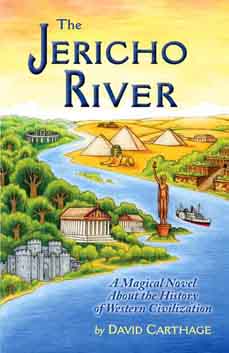
Plot Introduction: Jason Gallo is like any other high school student, except for one detail: his father, a history professor, is able to learn about the past by travelling through a world composed of people's dreams. Jason's father gets trapped in this world and it's up to Jason to rescue him. In the process, Jason travels through the various eras of Western civilization, encountering danger all along the way.
A Speech Given by David Carthage:
Review:
Unlike The Fault in Our Stars, I actually really liked this book the first time that I read it. I love the idea of using fantasy to introduce teens to history and attract their interest in it. I liked the various sketches that Carthage included in his story, because they illustrated elements of history that, before reading this book, I had only imagined. I enjoyed William Gallo's notes at the beginning of each chapter, which provide the reader with introductory facts about each historical aspect in a humorous and snarky way.
Unlike The Fault In Our Stars, I really disliked this book the second time that I read it. I think that the first time that I read this book, I was so excited about the concept that I basically ignored every single flaw about the book itself. Thankfully, I re-read this book in the week before class and my eyes were opened. This book started as such a great idea, but its implementation is so flawed. I think that part of the problem is that Carthage tried to cover thousands of years in the scope of three hundred pages. As a result, the story somehow manages to drag and feel rushed at the same time. Jason literally travels through centuries before he finally accomplishes his goal, yet because Carthage has to cover so much history, he only visits each society without actually delving into the nuances of each of them.Additionally, the characters are bland, undeveloped, and one-dimensional. Carthage's writing style is sloppy and tedious. Dialogue is stilted. The chapters are episodic, which could work for a young adult audience, who is likely to be easily distracted and accustomed to short chapters, or could be seen as choppy. All of this results in a story that tries to cover way too much information in way too few pages, a story that is, frankly, boring and difficult to get through - unless you're just so excited about the concept that you completely ignore the actual book. I think that all of these problems could be remedied if Carthage had made this a trilogy - maybe writing one book to cover ancient history, another to cover early modern history, and a third to cover modern history. That way, he could have further developed his plot, his characters, and gone into further detail about each civilization. I think that a trilogy would have been far more successful than trying to cram the entire history of Western civilization into a single novel.
Recommended to:
Although I personally think that this book has LOTS of room for improvement, it is not entirely flawed and I think that in some cases, it could actually work really well. I could see this being a great book to use in a mid-level history class focusing on Western civilization. Teachers could have students read a chapter for each unit to introduce them to key concepts and hook their interest in the topic. Although its implementation lacks style, I maintain that the concept is great and I think that this could work for introducing students to basic historical concepts. However, if teachers intend to use this book in that way, they would have to point out any historical inaccuracies or artistic license that Carthage takes - and there's a lot of it. Although this book contains lots of great facts, there's also a lot of manipulation for plot purposes and it's important that teachers identify these if this book is to be used as a supplement to lessons. Another potential strength to this book is that the episodic format could appeal to reluctant readers, so this might be a good book to hand to students who lack enthusiasm about reading - challenge them to read a chapter a day, but many of the chapters end in cliffhangers, which might encourage reluctant readers to keep reading. Again, while this book was not my favorite that I read for class, it still has potential for use in a classroom setting and I think that if used in the right setting, it could actually be quite effective.

 Log in with Facebook
Log in with Facebook 





